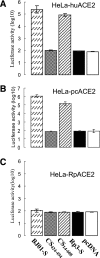Difference in receptor usage between severe acute respiratory syndrome (SARS) coronavirus and SARS-like coronavirus of bat origin
- PMID: 18077725
- PMCID: PMC2258702
- DOI: 10.1128/JVI.01085-07
Difference in receptor usage between severe acute respiratory syndrome (SARS) coronavirus and SARS-like coronavirus of bat origin
Abstract
Severe acute respiratory syndrome (SARS) is caused by the SARS-associated coronavirus (SARS-CoV), which uses angiotensin-converting enzyme 2 (ACE2) as its receptor for cell entry. A group of SARS-like CoVs (SL-CoVs) has been identified in horseshoe bats. SL-CoVs and SARS-CoVs share identical genome organizations and high sequence identities, with the main exception of the N terminus of the spike protein (S), known to be responsible for receptor binding in CoVs. In this study, we investigated the receptor usage of the SL-CoV S by combining a human immunodeficiency virus-based pseudovirus system with cell lines expressing the ACE2 molecules of human, civet, or horseshoe bat. In addition to full-length S of SL-CoV and SARS-CoV, a series of S chimeras was constructed by inserting different sequences of the SARS-CoV S into the SL-CoV S backbone. Several important observations were made from this study. First, the SL-CoV S was unable to use any of the three ACE2 molecules as its receptor. Second, the SARS-CoV S failed to enter cells expressing the bat ACE2. Third, the chimeric S covering the previously defined receptor-binding domain gained its ability to enter cells via human ACE2, albeit with different efficiencies for different constructs. Fourth, a minimal insert region (amino acids 310 to 518) was found to be sufficient to convert the SL-CoV S from non-ACE2 binding to human ACE2 binding, indicating that the SL-CoV S is largely compatible with SARS-CoV S protein both in structure and in function. The significance of these findings in relation to virus origin, virus recombination, and host switching is discussed.
Figures







References
-
- Berry, J. D., S. Jones, M. A. Drebot, A. Andonov, M. Sabara, X. Y. Yuan, H. Weingartl, L. Fernando, P. Marszal, J. Gren, B. Nicolas, M. Andonova, F. Ranada, M. J. Gubbins, T. B. Ball, P. Kitching, Y. Li, A. Kabani, and F. Plummer. 2004. Development and characterisation of neutralising monoclonal antibody to the SARS-coronavirus. J. Virol. Methods 12087-96. - PMC - PubMed
-
- Reference deleted.
Publication types
MeSH terms
Substances
LinkOut - more resources
Full Text Sources
Other Literature Sources
Miscellaneous

